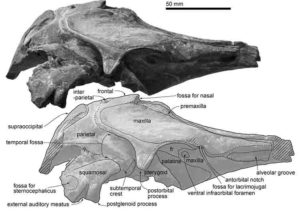
A new dolphin species likely from the Oligocene was discovered and described in Ecuador, according to a study published December 20, 2017 in the open-access journal PLOS ONE by Yoshihiro Tanaka from the Osaka Museum of Natural History, Japan, and colleagues.
Many marine fossils described in previous research have been from long-recognized temperate regions such as South Carolina, off the coast of Oregon, Hokkaido and New Zealand. Few equatorial and polar fossils are currently known.
While in the tropical region of Santa Elena Province, Ecuador, the authors of this study found a small dolphin skull, which they identified as representing a new species, Urkudelphis chawpipacha, based on facial features. The dolphin skull had a bone crest front and center on its face, above the eye sockets. This species stands apart from other Oligocene dolphins with its shorter and wider frontal bones located near the top of the head and the parallel-sided posterior part of its jaw. The authors also conducted a phylogenetic analysis which revealed that the new species may be the ancestor of the nearly-extinct Platanistoidea, or river dolphin, and may have lived during the Oligocene era.
The fossil is one of the few fossil dolphins from the equator, and is a reminder that Oligocene cetaceans may have ranged widely in tropical waters.
Reference:
A new tropical Oligocene dolphin from Montañita/Olón, Santa Elena, Ecuador. DOI: 10.1371/journal.pone.0188380
Note: The above post is reprinted from materials provided by PLOS.










